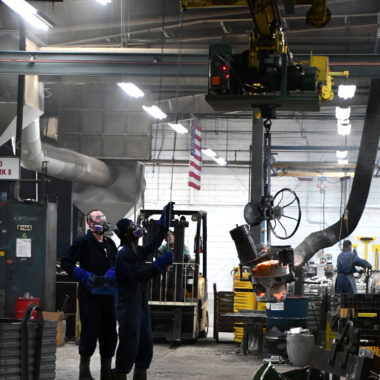Crafting Perfection: How to Achieve High-Quality Aluminum Castings Whenever
In the world of aluminum casting, the quest of excellence is a continuous journey that calls for a meticulous method and an eager understanding of the intricacies involved. Accomplishing regular top quality light weight aluminum spreadings requires a comprehensive grasp of the procedures, from picking the appropriate alloy to performing exact mold and mildew layouts and meticulously controlling casting specifications.
Recognizing Light Weight Aluminum Spreading Procedures
Light weight aluminum casting procedures, important in the manufacturing industry, involve the elaborate improvement of liquified light weight aluminum into solid types with a collection of meticulously regulated actions. Recognizing these procedures is extremely important to attaining high-quality aluminum spreadings consistently - about aluminum casting. The primary methods used in light weight aluminum casting are die spreading, sand casting, and financial investment spreading

Each of these procedures has its advantages and is chosen based upon aspects like complexity, volume, and preferred surface of the aluminum casting. about aluminum casting. Recognizing the complexities of these techniques is critical for suppliers intending to generate premium aluminum castings regularly
Picking the Right Aluminum Alloy
Selecting the appropriate light weight aluminum alloy is an important choice in the production of premium aluminum spreadings. The option of alloy dramatically influences the buildings and attributes of the final product. Various light weight aluminum alloys offer differing levels of strength, corrosion resistance, machinability, and thermal conductivity. When choosing an aluminum alloy for spreading, it is vital to consider the particular needs of the application to make sure optimal efficiency.
One of the most commonly used aluminum alloys for casting is A356 - about aluminum casting. For applications requiring high stamina, 7075 light weight aluminum alloy is a prominent selection due to its exceptional strength-to-weight ratio.
In addition to mechanical properties, considerations such as expense, accessibility, and post-casting procedures need to likewise influence the choice of the ideal light weight aluminum alloy. By very carefully examining these factors, producers can guarantee the production of premium aluminum spreadings that meet the wanted requirements.
Applying Correct Mold Design
Developing a reliable mold and mildew style is critical for making certain the effective manufacturing of premium aluminum castings. Proper mold and mildew style plays a significant role in attaining the desired features of the last product. To implement a successful helpful resources mold design, variables such as material flow, cooling down prices, and part geometry must be meticulously thought about.
One secret aspect of mold design is ensuring correct dental filling and solidification of the light weight aluminum within the mold dental caries. This includes designing jogger and gating systems that promote smooth metal circulation and avoid defects such as air entrapment or insufficient dental filling. Furthermore, incorporating cooling networks into the mold style aids manage solidification prices and minimize the threat of porosity or shrinking defects.

Controlling Casting Parameters

Ensuring Post-Casting High Quality Checks
To preserve the high quality of aluminum spreadings, thorough post-casting quality checks are necessary. After the spreading procedure is finished, it is important to make sure that the last items meet the wanted specifications and requirements.
Dimensional precision is an additional critical aspect that should be confirmed throughout post-casting Full Report high quality checks. Measurements of essential measurements and tolerances must be required to verify that the castings comply with the called for requirements. In addition, mechanical properties such as firmness, tensile toughness, and influence resistance might need to be assessed with material screening to make sure that the castings possess the necessary strength and longevity for their desired application.
Final Thought
In verdict, accomplishing top quality aluminum castings calls for a detailed understanding of the spreading processes, selecting the appropriate alloy, designing mold and mildews successfully, managing casting specifications thoroughly, and performing post-casting top quality checks carefully. By complying browse this site with these actions, makers can consistently create aluminum castings that fulfill the highest possible standards of quality and performance.
Achieving consistent high-quality aluminum castings demands an extensive understanding of the processes, from selecting the appropriate alloy to executing specific mold and mildew layouts and diligently controlling spreading parameters. The key approaches used in aluminum spreading are pass away casting, sand casting, and investment casting.
Financial investment casting, likewise recognized as precision casting, entails developing wax patterns that are covered in ceramic to form mold and mildews.Selecting the suitable light weight aluminum alloy is a critical choice in the manufacturing of top quality light weight aluminum castings.Ensuring exact control over casting criteria is necessary for keeping uniformity and high quality in aluminum casting production.